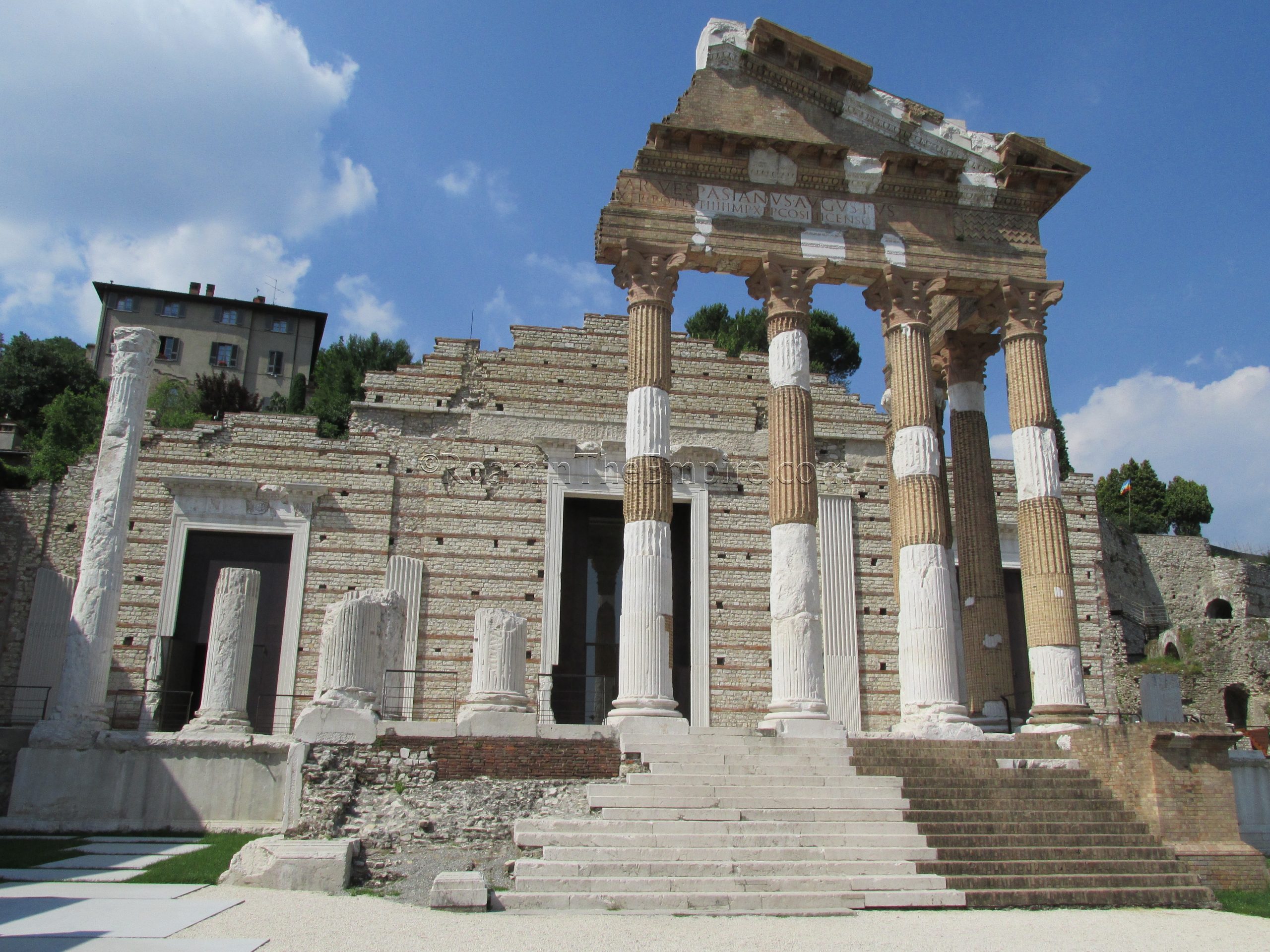
The modern town of Brescia is situated in Northern Italy at the foot of the Alps, between Lake Iseo and Lake Garda (Lacus Sebinus and Lacus Benacus in antiquity, respectively) and along the Mella River (seemingly retaining it’s ancient name). In the Roman period, the settlement was called Brixia, seeming to derive from the Celtic or Ligurian word ‘brik,’ meaning a high point or rise, likely referring to the Cidnus Hill. The Cidnus Hill gets its name from a supposed Ligurian king, Cidnus, who legendarily founded a settlement on the hill.
A settlement does seem to have existed as early as about 1200 BCE, perhaps by the Ligures or Etruscans, though the Roman sources attribute it to the Cenomani when they migrated to the area in the 7th century BCE. Strabo mistakenly gives credit for the settlement of Brixia to the Cenomani allies and fellow 7th century migrants, the Insubres. Roman hegemony came to Brixia following the Battle of Telamon in 225 BCE in which a confederation of Gallic tribes in Northern Italy were subjugated by the Romans, though the Cenomani aided Rome in that conflict. The people of Brixia are noted as continuing to assist the Romans against a Boii insurrection in 218 BCE and remaining loyal to Roman even though most of the other Cenomani settlements joined in a general rebellion in Cisalpine Gaul during the Second Punic War. Brixia also seems to have been loyal in the Gallic uprisings following the Second Punic War, and so enjoyed some degree of autonomy following the episode.
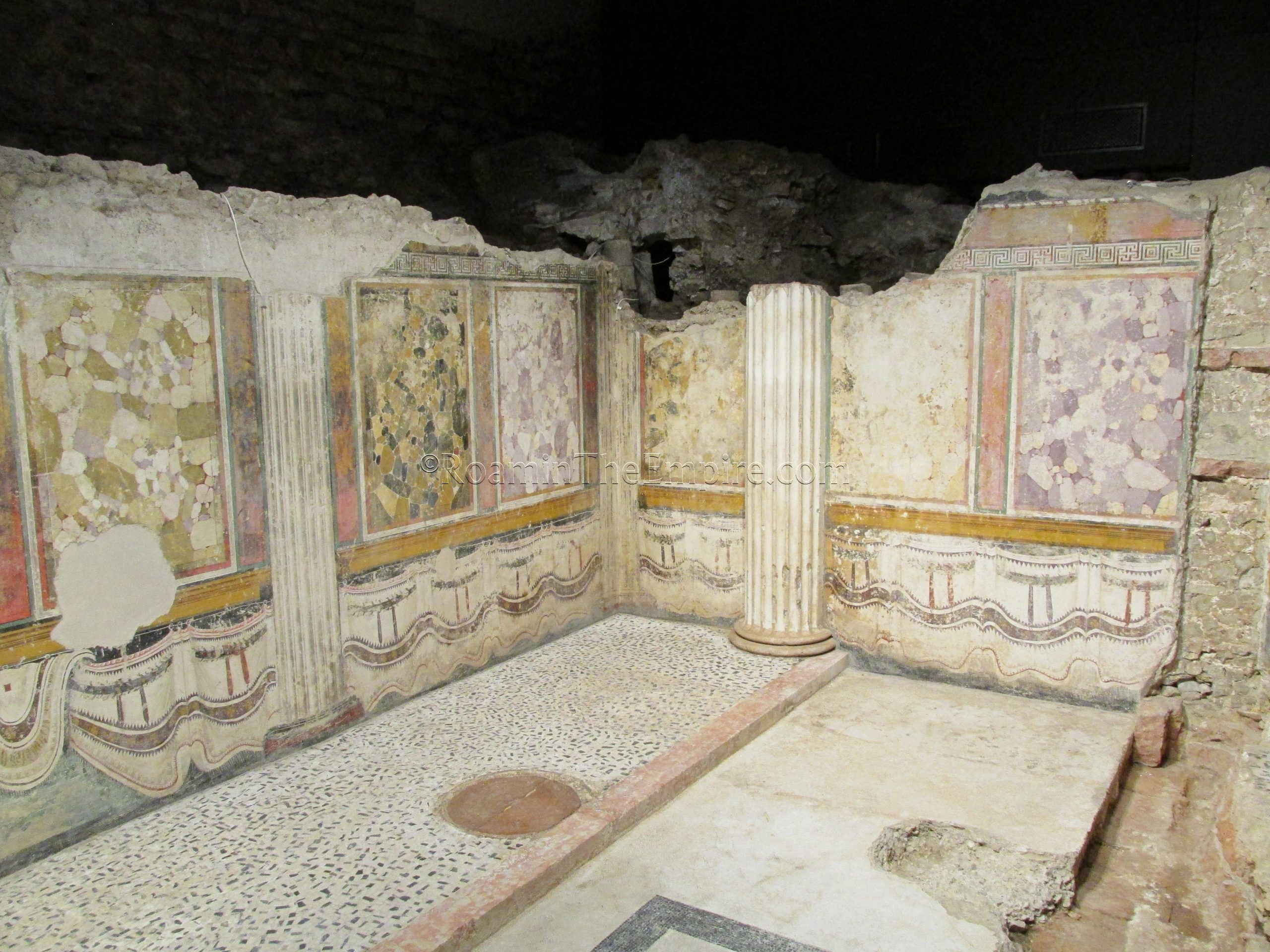
Brixia was granted Latin Rights as part of the Lex Pompeia de Transpadanis in 89 BCE and became a civitas responsible for a rather large territory in its vicinity. Catullus, who was born in nearby Verona a few years later, mentions Brixia in Carmen 67, naming the geographic features of the Cidnus hill (called Cycneae) and Mella River. He also alludes to Brixia being the ‘mother’ of Verona and beloved by the people of Verona. This is perhaps an allusion to Brixia being the capital city of the Cenomani, who also settled the area of Verona.
The Lex Roscia in 49 BCE gave the region, and the people of Brixia Roman citizenship. Augustus founded a civic colony, the Colonia Civica Augusta, there sometime during his reign. The city was damaged during the civil wars of 69 CE, but benefited from a reconstruction project launched by Vespasian. A battle was fought between Constantine and supporters of Maxentius near Brixia in 312 AD, resulting in a victory for Constantine. The city was besieged and sacked twice in the 5th century CE, first by Alaric I in 402 CE and then by Attila in 452 CE.
Getting There: Brescia is a relative significant city and is located along the train route between Milan and Verona. Trains with service to Brescia leave at least once an hour from Milan through most of the day. The typical ride takes a little over an hour to reach Brescia and costs just 7.30 Euro. Milan has two international airports with extensive service to Europe and abroad between them. Once in Brescia, the core of the Roman town is about a 20-30 minute walk from the train station, though a quick jump on the metro line to Vittoria station can save a few minutes and a bit of walking.
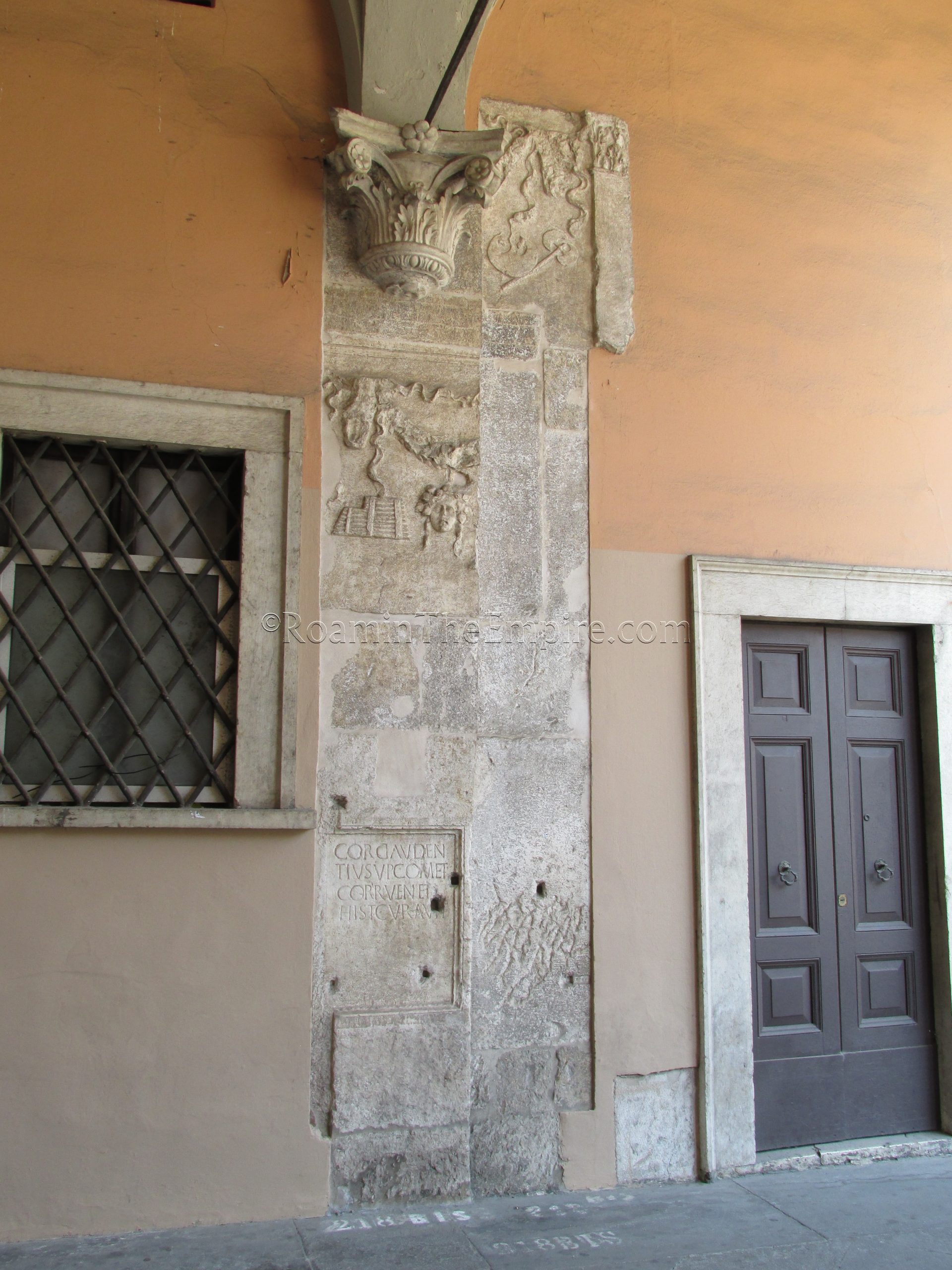
The first place worth visiting is the Piazza della Loggia. The area of the loggia was outside of the walls of Roman Brixia and was constructed starting at the end of the 15th century CE. The façade of the palazzo that dominates the southern side of the piazza, the Monte di Pietà Vecchio, is constructed of a heavy amount of Roman spolia in the wall facing the piazza. Nearly all the corners facing the piazza are braced by a Roman inscription with various other decorated and un-decorated slabs filling in. There’s even part of a large, monumental inscription over several blocks at about the midway point. Down the corridor at the western portal, there’s some spolia in the walls as well, including an inscription and what appear to be some architectural reliefs. These are all visible from public areas, so there is no limitation of access and they can be viewed at any time. It’s right close to the metro stop needed to get to the main Roman area of Brixia as well, so it’s the perfect starting point no matter what route one takes.
About a five minute walk to the east is the archaeological area of the Capitolium, the Parco Archeologico di Brescia Romana. The entrance to the park, which spans a few blocks, is located at Via dei Musei 55. The archaeological area is open in the summer (June 16 to September 13) Tuesday through Friday from 9:00 to 17:00. On Saturdays, Sundays, and holidays, it is open 9:00 to 18:00. The rest of the year the hours shift to 10:00 to 18:00 Tuesday through Friday and 10:00 to 19:00 on Saturdays, Sundays, and holidays. It is closed on non-holiday Mondays year round. The full admission price is 8 Euros.
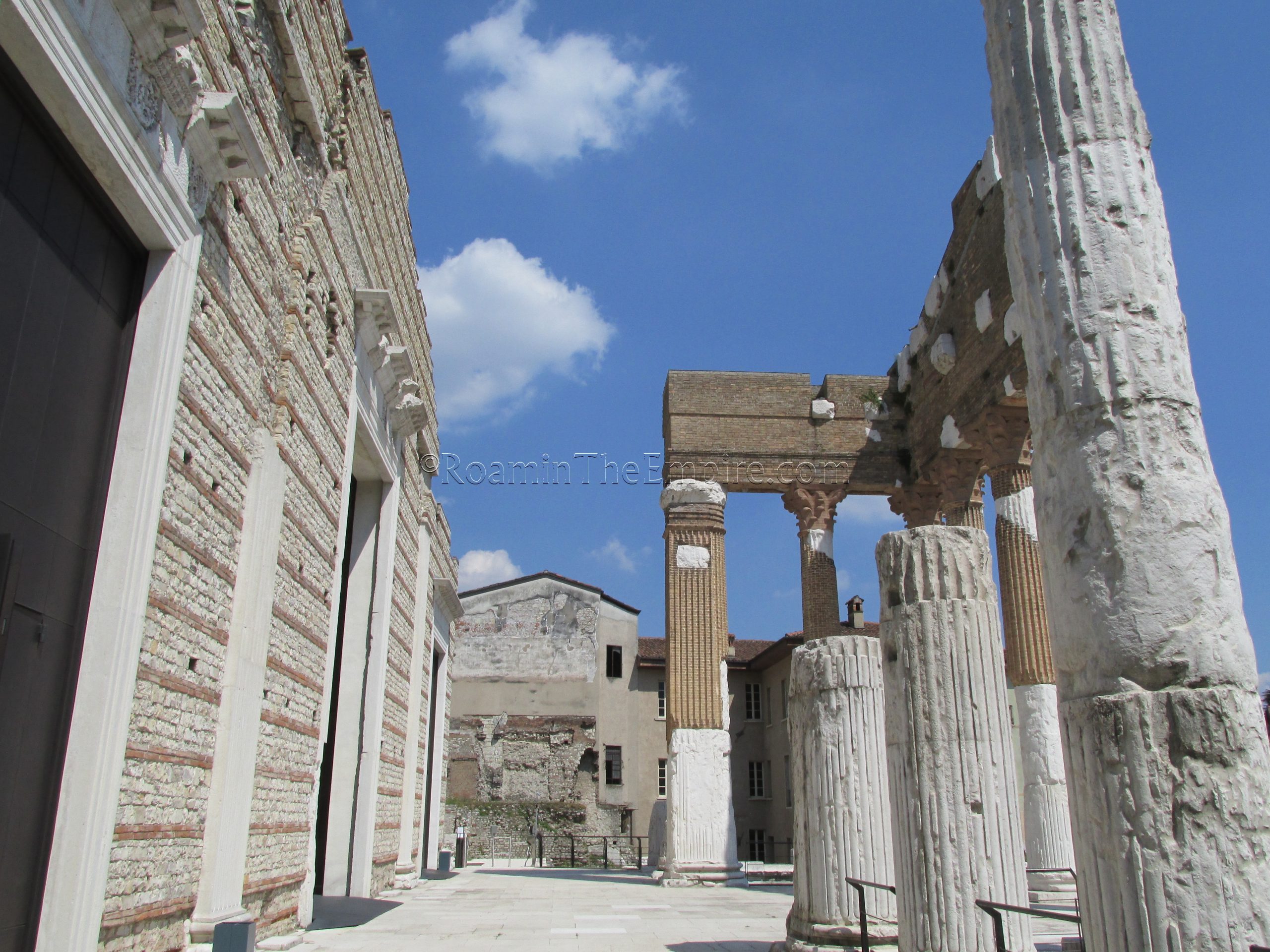
The Parco Archeologico di Brescia Romana is a collection of three separate buildings; the Capitolium, the theater, and a Republican era sanctuary. Because of its proximity to the ticketing office, I chose to visit the sanctuary first. The subterranean remains of the Republican sanctuary are accessed via an entry just to the left (west) of the entrance to the park.
The area of the Republican has evidence of occupation on the site dating back to the 4th century BCE with hearths and pottery associated with the Cenomani found at those layers. Sometime in the 2nd century BCE, a simple religious structure seems to have been constructed with a beaten earth floor and wood post construction. That temple was destroyed and then the Republican sanctuary was constructed in the early 1st century BCE, likely sometime shortly after the passage of the Lex Pompeia de Transpadanis, perhaps between 89 and 75 BCE. Works were carried out on the sanctuary during the Augustan period, before it was finally dismantled during the Flavian period to make way for the construction of the Capitolium.
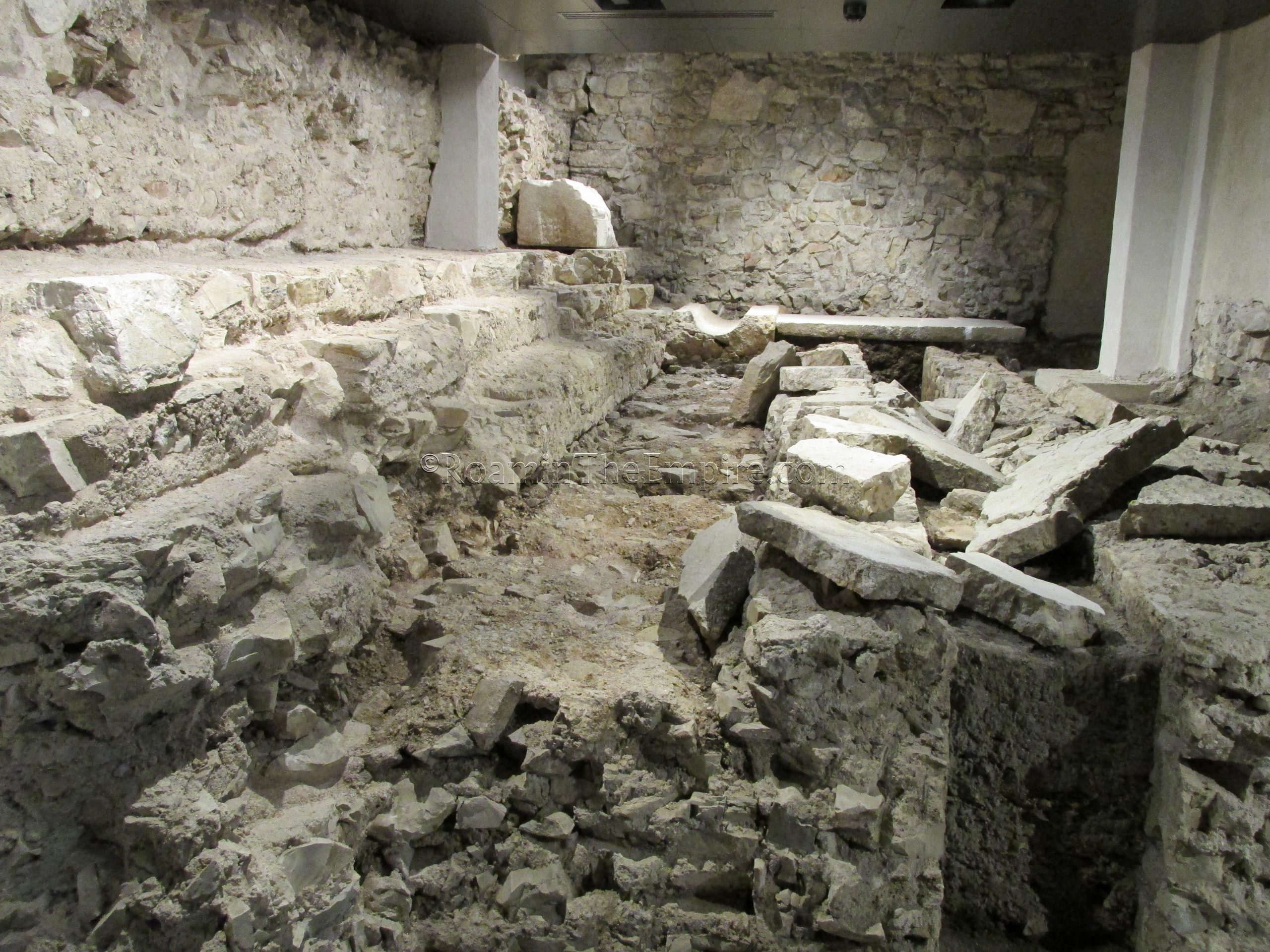
The archaeological area of the Republican sanctuary is divided up into a few different rooms. The first room contains the foundations of the western portico of the Capitolium, which were built over the remains of the Republican sanctuary. A plastered section of the exterior wall of the Republican sanctuary on which the portico was built has been exposed near the doorway to the next room. The next room contains some artifacts found in the excavations of the sanctuary, including a coin found that provided the terminus post quem of the Republican sanctuary. A cut in the floor on the far side of the room also displays the earlier 2nd century BCE occupation layer.
Ascending a staircase up takes one to the pronaos area of the Republican temple, of which the flooring is finished opus scutulatum. Some of the exterior decoration of the temple is on display here, and the plastered white exterior wall of the cella of the temple. An inscription displayed here and associated with the temple notes that Lucius Hostilius Fronto and Gaius Clodius Merga were the patrons responsible for the opus albariorum decoration, the white plaster. The dating of the inscription is unclear. The temple consisted of 4 connected cellae; with this pronaos and cella in the archaeological site being the fourth and easternmost of them.
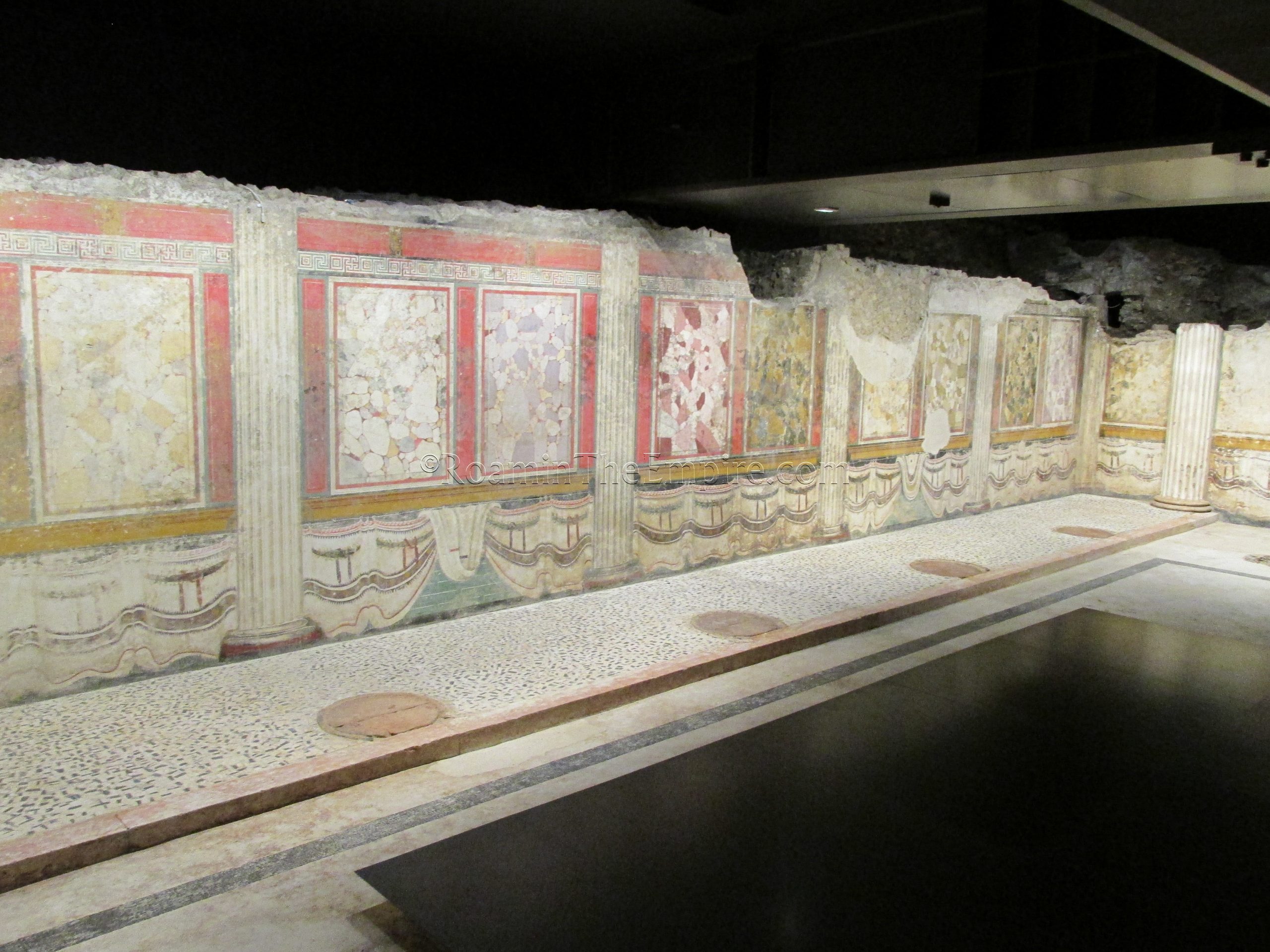
The final room of the archaeological area is the interior of the cella of the temple, which is finely decorated in both wall paintings and flooring. The wall painting dates to the initial construction of the temple in the early 1st century BCE and depicts painted slaps of marble between painted columns on the side and faux columns on the ends. Painted drapery runs along the lowest register of the wall paintings. The main floor is mosaicked, while a small ledge closer to the walls, which would have divided the cella into three sections, is covered again in opus scutulatum. In the far corner, a different wall and floor decorating scheme is exposed. The face of a female divinity, believed to belong to the acrolith cult statue of the temple, was also found here. There are a few informational signs in English and Italian throughout the site.
The Capitolium was constructed during the reign of Vespasian in 73 CE. Copies of the monumental inscription from which this information was gleaned are present in the partial reconstruction of the façade of the temple. The original fragments of the inscription are on display in the central cella of the temple. The apparent impetus for the construction of the temple was the victory of Vespasian over Vitellius at the Second Battle of Bedriacum on October 24, 69 CE, which took place about 50 kilometers south near Cremona. A bronze statue of Victory was found, among others, in the Capitolium (now in the Museo di Santa Giulia). A fire, possibly associated with the Barbarian invasions, destroyed the temple in the 4th century CE, after which it was not rebuilt. A medieval landslide of the Cidnus Hill buried the Capitolium, and it was only rediscovered in 1822.
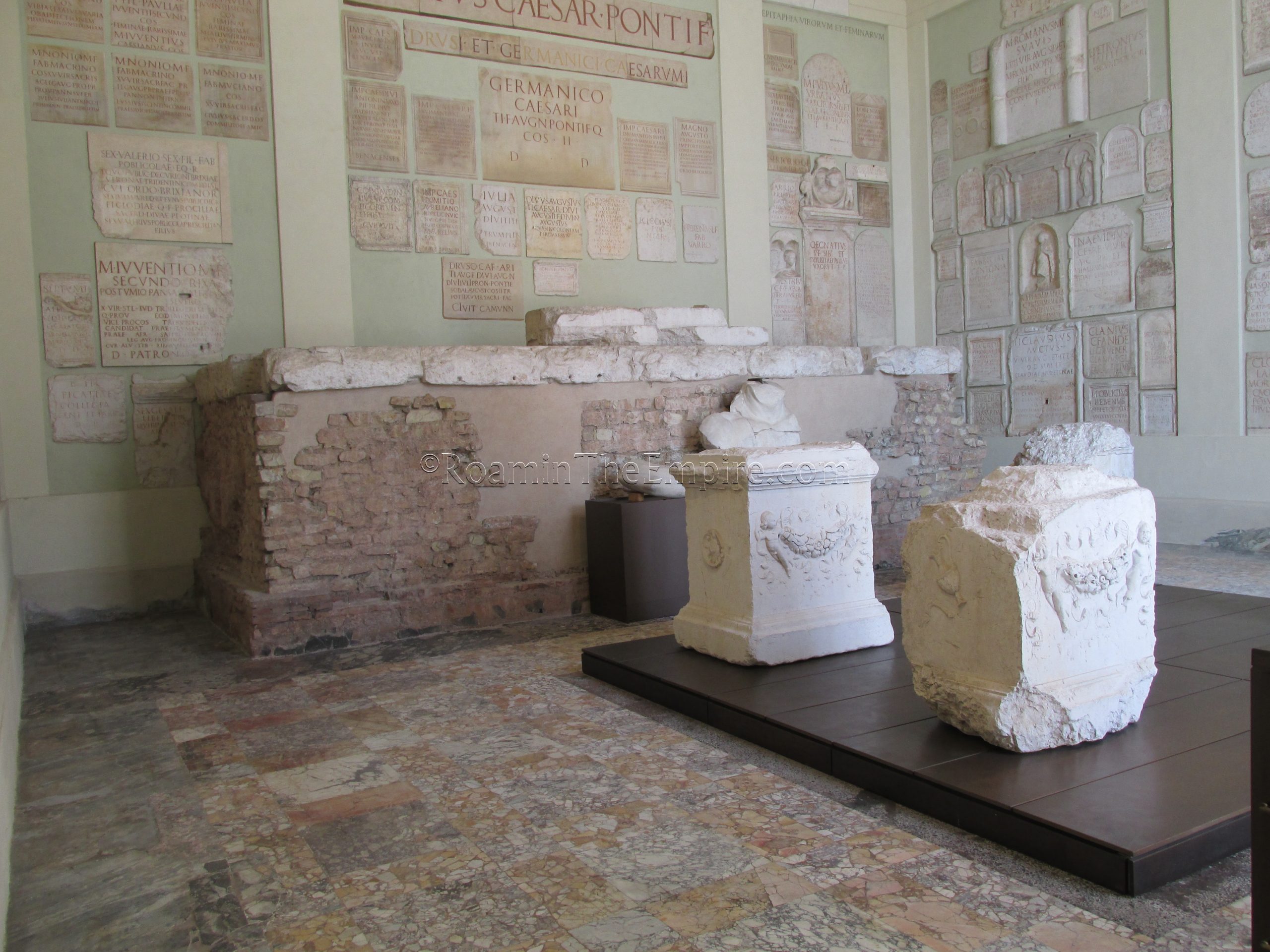
Part of the staircase of the temple survives, which then faces onto the reconstructed façade of the pronaos porch area of the temple. Fragments of many of the columns are reconstructed as well. The form of the triple cella is easily identifiable. Much of the flooring in Giallo Antico, Pavonazzetto, and African marble is preserved throughout the temple; though it is covered over in the area of visitor traffic, and visible in non-traffic areas. The altars are also visible at the rear of all three of the cellae. In the westernmost cella, some of the marble decoration that faced the interior walls of the temple is also visible. Two statue heads of Minerva and one of Silenus were found in this cella and are now displayed there.
The middle and largest cella was dedicated to Jupiter. The podium and fragments of the monumental cult statue of Jupiter are on display here, as well as other objects that decorated this room, including a monumental candelabra. Some small fragments of Cipollino marble that faced the walls can be seen on the east wall. The cella held the so-called Museo Patrio in the 19th century, of which the inscriptions set into the modern walls of the room belonged. The inscriptions are divided thematically, but, unfortunately their position on the walls makes it hard to appreciate most of them. The easternmost cella is mostly taken up by an audiovisual presentation, but the altar and parts of the floor are visible on the far end. A couple of informational signs in English and Italian are located in the cellae.
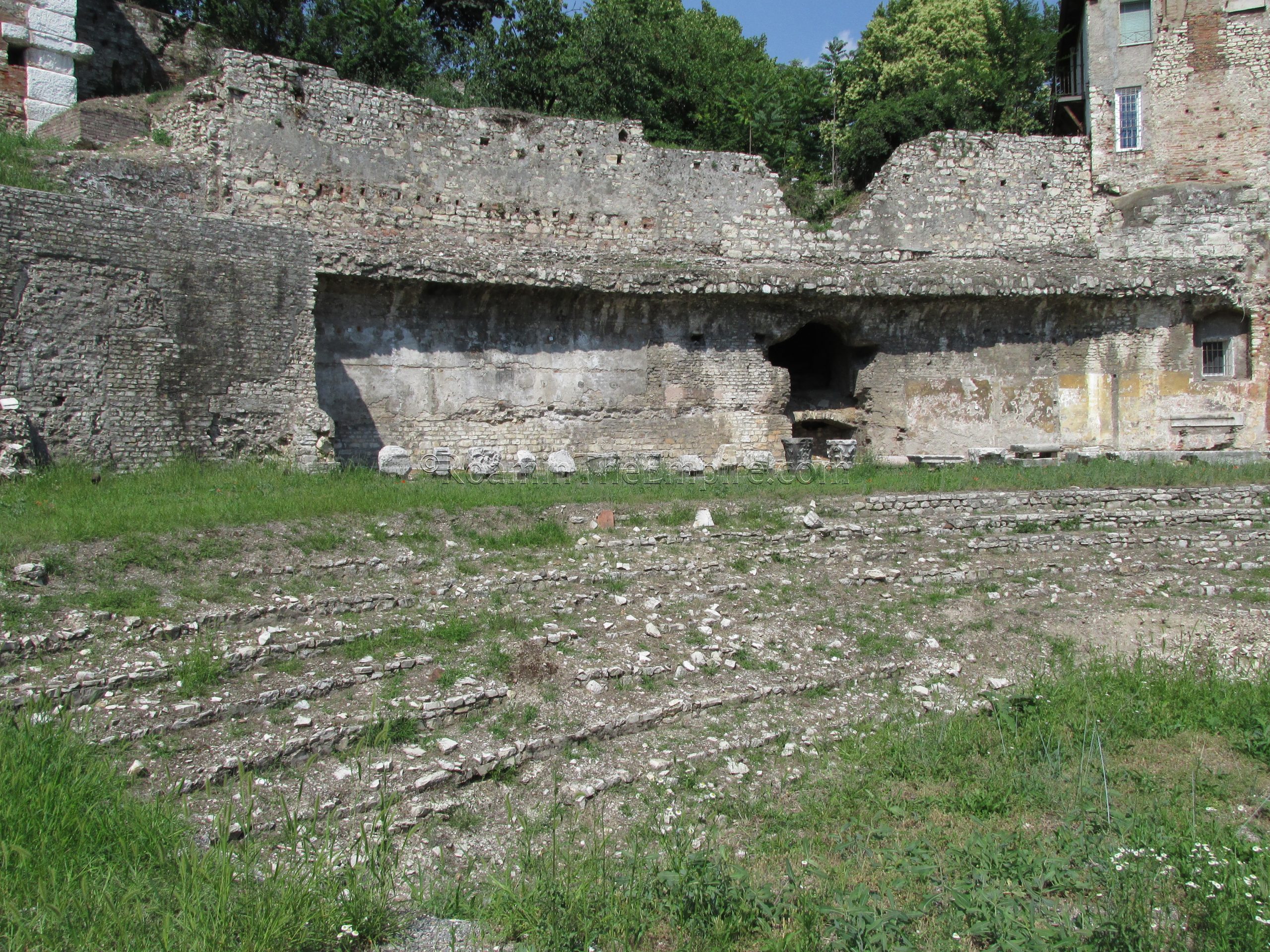
A portico connects the Capitolium and the adjacent theater to the east. Like the Capitolium, the current form of the theater was constructed during the Flavian period and partially uses the slope of the Cidnus Hill to support the structure. The earliest construction of the theater may date to the Augustan period. There was a major renovation during the reign of Septimius Severus, and like the Capitolium, seems to have been severely damaged in the 4th century CE fire. An earthquake in the 5th century CE further damaged the structure. Capacity seems to have been about 15,000 spectators.
Aside from some of the lowest rows of seating, much of the cavea are gone, and that which does remain is extremely fragmentary. The supporting structures of the seating, however, is intact for much of the rear (north side) of the theater. A good portion of the scenae is also intact and excavated and visible. The visitor path is limited and there is no direct access to much of the theater.
Sources:
Catullus, Carmen 67.
Josephus. Bellum Judaicum, 4.545.
Livy. Ab Urbe Condita, 5.35, 21.25, 32.30.
Pliny the Elder. Historiae Naturalis, 3.23.
Ptolemy. Geographica, 3.1.
Smith, William. Dictionary of Greek and Roman Geography. Walton & Murray, 1870.
Stillwell, Richard, William L. MacDonald, and Marian Holland. McAllister. The Princeton Encyclopedia of Classical Sites. Princeton, NJ: Princeton U Press, 1976.
Tacitus. Historiae, 3.27.


